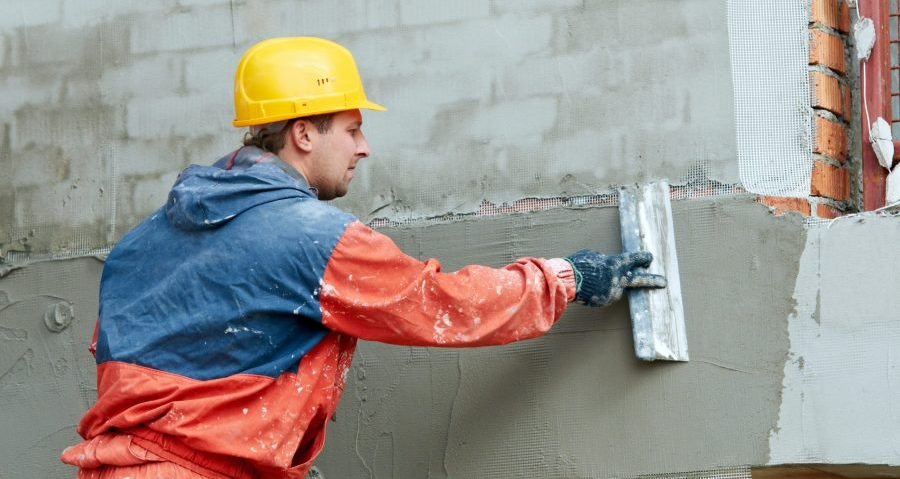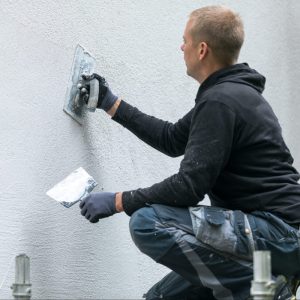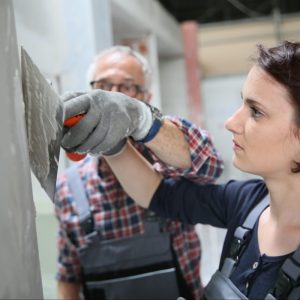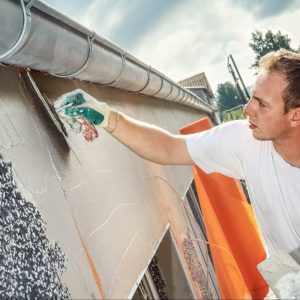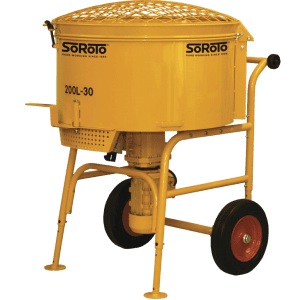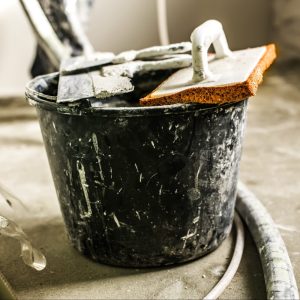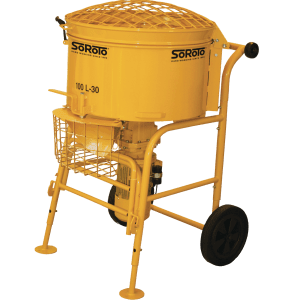Rendering vs Plastering
Whilst plaster and render may feature similar practices that many people outside of the trade can struggle to distinguish between the two, they are in fact different and are used to perform different tasks.
Fundamentally, the main differences lie in their composition. Whilst both are composed primarily of cement, sand, water and lime gypsum, render actually has a much heavier composition compared to plaster.
In this blog post, we take a closer look at the two materials and explain the difference between plaster and render.
About rendering
Rendering is the coating of external walls, whilst plastering is the coating of interior walls.
The rendering process is used to coat exterior surfaces of buildings and contains a higher percentage with its composition. It is applied to the outside of buildings to make the outside facade more visually appealing and also provides waterproofing and fireproofing capabilities.
It consists of lime gypsum. sand and cement, bonding agents, drying additives and colouring. The lime gypsum is key to giving the coating its creamy appearance and smooth finish.
A properly applied render is incredibly durable. It acts as a protective layer for the home and is able to withstand everything that the brickwork can and more.
One of the handiest things about rendering is that colour pigments can be added to the material before being applied to the building – reducing painting costs.
about plastering
Plastering is the process of coating the interior walls and ceilings of a building.
The plaster mixture contains less cement than render and utilises less coarse sand – this provides a lighter, smoother finish than external render.
Both plaster and render are mortar coatings that rest on top of blockwork. However, plaster is not weather resistant, meaning that serves more of a decorative function. It is water-repellent and easily cleaned. It also has fireproofing qualities.
Plaster must be set and completely dry before walls are painted and decorated. Freshly plastered walls should be left to fully dry for at least one week to a month before painting.
It will be clear that the plaster is completely dry as there are no dark patches visible. There are also other factors which will influence the speed at which plaster dries: such as the number of layers of plaster used, central heating and seasonal weather.
In older buildings where walls were originally made from mud or clay, the application of plaster materials will make the internal walls fire-resistant.
How to mix render
Rendering involves the application of cement mixture to walls to create a textured or smooth surface. It has fire-rating and waterproof qualities and also holds aesthetic appeal.
Most renders are typically made up of sand, water, cement and lime – and mixed together using a forced action mixer.
A standard ratio used in creating this is 6 parts sand, 1 part cement and 1 part lime (6:1:1). Any kind of cement can be used, however the sand should have a fine texture and be free from impurities.
It is recommended that specialist sand is used. Coarse sand is usually used for the base layer, and sand with a slightly fine texture as the top layer.
All Division Building Ltd recommends the 6:1:1 ratio for the following reasons:
“It is crucial not to use more than one part lime to one part cement, as the lime needs cement to assist it in setting. The right amount of lime makes the mix creamy and elastic. Lime makes the render self-curing. Thus, if the building moves as a result of contraction and expansion, the render will move with it slightly, preventing cracking. Where cracking does occur, the lime could re-calcify in the crack a little.
“The mistake many renderers make is to leave lime out of their render. They often use plasticisers instead, which incorporates many bubbles into the mix. Even though plasticisers are good, lime has proven to be a better option.”
How to mix plaster
Plaster is mixed by using water and plaster. As with rendering, it is recommended that a forced action mixer is used. A paddle mixer is also suitable.
Other tools and materials needed include various types of trowel, a plasterers float, a hawk board, two buckets, PVA, dustsheets, a stepladder (or similar) and a dust mask.
The area should first be protected from spillage and debris, by using a dustsheet. It is recommended that screen tape is used to cover any cracks and mask joints between boards.
The PVA is applied to walls prior to plaster being added. This is then left to dry.
The plaster then mixed using either a forced action mixer or mixing paddle whisk.
If a mixing paddle is used, then fresh water should be poured into a completely clean bucket. Half a bag of finishing plaster should be added to the bucket, leaving the mix as roughly 50/50.
Immediately use the mixer drill and paddle to mix up the contents of the bucket before lumps appear. Add plaster slowly to the mix whilst preventing any lumps.
For a guide on how to apply plaster to walls click here.
Paddle whisks
Plaster and render mixing can be undertaken using a forced action mixer or a paddle mixer and whisk.
Paddle mixers are versatile mixers which are used to create consistent and lump-free mixtures.
The beauty of paddle mixers is that they are handheld allowing for greater control.
The 1300w Paddle Mixer is SoRoTo’s largest handheld continuous-use electric paddle mixer. When added to the GA90K, GA120K, GA120 and GA140, mixing whisks are ideally suited to mixing plaster and forming a smooth and consistent mix. The whisks are inverted which means mixing in a bucket or builder’s tub is easier and removes the amount of twisting.
Alternatively, browse the 850w Paddle Mixer and 1220w Paddle Mixer here.
Browse all Paddle Whisks here.
Conclusion
In summary, the difference between plastering and rendering are:
- Rendering and plastering are similar processes of covering walls that have been erected with brick and mortar with a coating.
- More cement is used in the mixture used for render as the major purpose is to make strong walls that can withstand the effects of nature.
- Less cement is used in plaster as the major purpose is to make walls as smooth as possible so that they look appealing when painted.
Both plastering and rendering refer to the act of coating mortar over the brickwork. However, a distinction is made between outer walls and walls inside a home and coating outside walls is referred to as rendering while covering inside walls to make them ready to be painted is called plastering. The major difference between the two is the strength of the material that is used for coating these walls as outer walls are subject to forces of nature. This is why render involves the use of a richer mixture containing more of cement than during the plastering process.
Both are simple processes, requiring a small number of tools and equipment, such as a forced action mixer or paddle mixer.
For more information on our range of mixers please do not hesitate to call on 01246 418144 or LiveChat with us during office hours, outside of these times you can email us.

